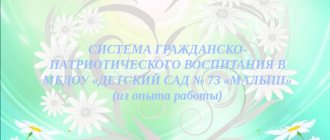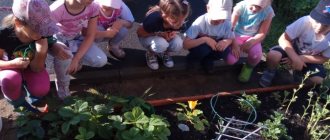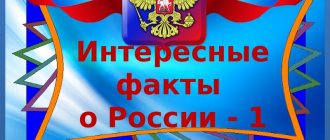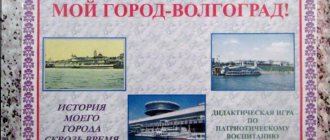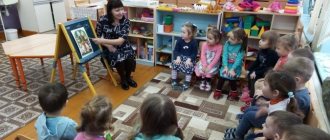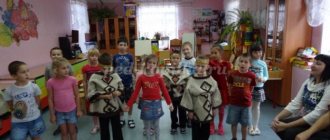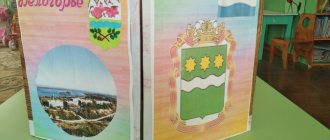MAGAZINE Preschooler.RF
Project: “My small Motherland.”Prepared and conducted by: teacher of the senior group of preschool education Lykhina A.V. Municipal state preschool educational institution "Kindergarten No. 9" in Kirensk.
Project passport:
PROJECT TYPE: cognitive-speech.
BY NUMBER OF PARTICIPANTS: group.
DURATION: long-term.
PARTICIPANTS: senior group students, teacher, music director, parents.
AGE: 5 years.
AUTHOR OF THE PROJECT: teacher of the senior group Lykhina A.V.
Problem: We, adults, want to instill in our children love for the Motherland, but it turns out we are not able to instill love for those closest to us - our home and kindergarten
Project goals: fostering a feeling of love for one’s hometown; the formation of a spiritual and moral attitude and a sense of belonging to one’s home, family, kindergarten.
Project objectives:
Systematize children's knowledge about the sights and nature of their native land.
Arouse positive emotions in the process of familiarization with local history material.
Teach methods of practical application of knowledge in gaming and speech activities.
Stimulate the manifestation of cognitive interest in the phenomena of the history of your city.
Promoting the active involvement of parents in joint activities with the child in family and kindergarten settings
Cultivate a respectful attitude towards the property of the native land.
Cultivate love for home.
“Cobweb” based on the project “My Small Homeland” .
Project implementation stages:
1. ORGANIZATIONAL.
Teacher:
- reveals the problem
- defines the goal
- outlines tasks to achieve the set goal.
Children:
- entry into the project.
Parents:
- elicit a positive response from parents
existing problem.
2. Activity planning:
Teacher:
GCD (cognitive development):
Conversations: “Native land” , “What do I know about my city?” , “History of the city” , “Sights of our city” , “When we are united, we are invincible” .
Acquaintance with the symbols of the city of Kirensk (coat of arms, flag).
Design of pages of the city chronicle “Our History” .
Excursion to the historian - local history museum.
Excursions to monuments of military glory, to the library.
Reading and learning poems about the Motherland, the nature of the native land.
Musical holiday “I love my town Kirensk” .
GCD (artistic and aesthetic development):
Exhibition of children's drawings “Why do I love my Motherland?” .
Modeling “Birds of the native land”
Construction of the “House on the Embankment”
Presentation “Architecture of the native land” .
Compiling stories: “Why do I love my Motherland?” , “Professions of our city” , “How did our city arise?” , "Where we live?" , “What is under our feet?” .
CHILDREN. Learning games of poems, participating in projects, exhibitions and productive activities; searching with parents for new knowledge about their small homeland.
PARENTS.
Conversations “Our Land” , “Wheel of History” .
Search for information about the history of the city of Kirensk.
Participation in the photo shoot “I explore the world” .
Participation in the design of pages of the city chronicle “Our History” .
Meetings with interesting people with the participation of parents.
View and participate in the holidays of our city..
The final stage.
A qualitative analysis of the changes occurring during work with children showed the following:
It was possible to clarify and systematize children’s knowledge about objects and natural phenomena, promote the development of verbal and logical thinking and the development of the emotional sphere of children.
positive dynamics are visible in changing the attitude of preschoolers to the world around them, in the development of ecological culture, in the formation of a sense of a small homeland and awareness of themselves as part of a large country called the Motherland.
This work allows us to fully implement the regional and partially federal components of the state educational standard.
| Next > |
Project “My Small Motherland”
Project type:
practice-oriented
Target:
- Joint search for solutions to project problems in a practical way (material for a photo album, layouts, etc.)
- Formation of prerequisites for search activity and intellectual initiative.
- Development of special methods of orientation - modeling and experimentation.
Tasks:
- To consolidate children's knowledge about their country - Russia, about their village.
- Introduce the history of the emergence of the village of Novaya Maina.
- Strengthen children's knowledge about the sights of their native village.
- To instill in children a sense of admiration for the beauty of their village.
- Involve parents in working on the project, creating a joyful atmosphere of creativity with the child.
- Develop the creative imagination and fantasy of children and parents.
Time frame for implementation of project activities:
September – December
Project participants:
Teachers, preparatory group students, parents, specialists.
Estimated results of the project:
- Design of the photo album “Native Village”
- Creation of a folder of drawings “The village of Novaya Maina through the eyes of children and parents.”
- Excursion to the library. A librarian's story about the formation of our village.
- Excursion to the museum.
- Making a model of “Our Village”.
- Creation of a mini-museum in a preschool educational institution
Stage 1:
PROJECT DEVELOPMENT
- Select methodological, popular science, and fiction literature.
- Select illustrative material.
- Select materials and attributes for games.
- Select materials for fine art activities and productive activities.
- Draw up a long-term action plan.
Stage 2: PROJECT IMPLEMENTATION
| PROGRAM SECTION | FORMS AND METHODS OF WORK |
| GAME ACTIVITIES |
|
| COGNITIVE ACTIVITY |
|
| SPEECH DEVELOPMENT |
|
| INTRODUCTION TO FICTION |
|
| THEATER ACTIVITIES |
|
| ART ACTIVITIES |
|
| PRODUCTIVE ACTIVITY |
|
| MUSIC |
|
| PHYSICAL DEVELOPMENT |
|
| WORKING WITH PARENTS |
|
STAGE 3:
PROJECT PRESENTATION
- We decorated a corner dedicated to our country.
- We decorated a corner dedicated to our village of Novaya Maina: in the corner, together with our parents, we set up a photo exhibition “The Village Then and Now”.
- Together with the art teacher we designed an exhibition of drawings “Transport of the immediate environment”
- Parents and children made models of “Village Attractions.”
- An exhibition of drawings “The Village Through the Eyes of Children and Parents” is planned in the corner.
- Excursion with children through the streets of the village.
- Joint walks with parents to the library, museum.
Short-term project “My Small Motherland” for the senior preschool group of the kindergarten
Lyubov Snoring
Short-term project “My Small Motherland” for the senior preschool group of the kindergarten
Duration: short-term (09/15/2014 - 09/29/2014)
Type of project: informational - creative.
Project participants: children, parents, teacher.
Children's age: 5-6 years.
Relevance: In pedagogical science, patriotic education has been and remains one of the most important areas. But the formation of patriotic consciousness is a long process that can be carried out throughout a person’s life. Preschool childhood can rightfully be considered the beginning of the formation of a person’s patriotic orientation.
Patriotic feelings are formed in the process of life and existence of a person located within a specific sociocultural environment. From the moment of birth, people instinctively, naturally and imperceptibly get used to their environment, nature, culture and way of life of their people.
A small child’s love for the Motherland begins with the relationship with the closest people - father, mother, grandmother, grandfather, with love for his nature, for home, for the street on which he lives, for the city.
Watching the children, I saw that they were curiously looking at postcards and photographs about their hometown and sharing their impressions. But, talking with children, I became convinced that children have a superficial understanding of the history of their hometown, as well as rare plants.
Goal: implementing an integrated approach to the formation of spirituality, moral and patriotic feelings in preschool children, introducing preschoolers to the history and culture of their hometown, local attractions, nurturing love and affection for their native land.
Tasks:
1. Form initial ideas about your country, your city.
2. Introduce children to state symbols: flag, coat of arms, anthem
3. Introduce the history of your hometown, its monuments and architecture (modern and ancient creations).
4. To sow and cultivate in children's souls the seeds of love for their native nature, for their native city, for their native home;
5. Cultivate interest in visiting cultural sites of the city.
6. Develop a caring attitude towards the city and its attractions,
cultural values, nature.
7. Arouse in children a sense of pride and interest in their city.
8. Encourage a desire to learn more about your hometown.
9. Bring to the understanding that our city requires careful treatment
to the historical heritage of our city.
10. Arouse desires to do something useful for your city of Isilkul.
11. Learning home addresses with children.
12. Develop basic research skills.
13. Develop children’s coherent speech; enrich and activate the vocabulary; memory, interest in gaming activities, creative and cognitive abilities, imagination.
Progress of work on the project.
Stage I: preparatory
1. A selection of materials, fiction on a given topic
2. Collection of illustrative material
3. Development of lesson notes
Stage II: main
Theory
Cognitive development
1. “My country Russia”
Goal: to develop in children of this age a sense of patriotism and respect for their homeland.
Objectives: familiarize children with such concepts as “Russia”, “Motherland”, “Fatherland”; overview of the symbols, the anthem of Russia and the capital; consolidation of received information
2. “Our hometown is Isilkul”
Goal: to develop in children of this age a sense of patriotism and respect for their small Motherland.
3. Conversation “My house, I’ll put it in order.”
Goal: To develop a culture of behavior in children, the desire to maintain cleanliness and order in the house, group, and area.
4. “Clean City” (ecology)
Goal: To clarify children’s knowledge about the importance of cleanliness of city streets and the role of a person in maintaining it.
Practice
Artistic and aesthetic development
1. Drawing: “The house where I live”
Goal: Activate thought processes
Objectives: To create conditions for reflecting in the drawing the idea of the place of residence as one of the “corners” of one’s homeland. Continue drawing simple plots. Develop creative imagination and compositional abilities. To foster patriotic feelings and interest in learning about one’s homeland
"Nature of the native land"
Goal: Activate thought processes
Objectives: Develop the ability to draw deciduous and coniferous trees, conveying the characteristic features of the structure of the trunk and crown (birch, oak, willow, aspen, spruce, colors; develop technical skills in drawing with pencils. Improve visual skills and develop the ability to create expressive images using various image media
"Administration of Isilkul"
Goal: Activate thought processes
Objectives: Enrich the content of visual activities in accordance with the assigned tasks of cognitive development. Teach children to create stories based on a familiar building, combining visual techniques (drawing and appliqué). Encourage children to embody their ideas and aesthetic experiences in artistic form.
2. Origami “Trees”
Goal: Activate thought processes
Objectives: Develop self-confidence.
-Learn to follow verbal instructions and sequences of actions. Stimulate the development of memory, including muscle memory.
-Introduce in practice basic geometric concepts.
-Learn to concentrate.
-Develop spatial imagination, visual perception of information.
3. Music listening to the anthem of the Russian Federation, songs about your hometown
Goal: to introduce students to the Russian anthem in a historical retrospective, their hometown.
Tasks:
— Development of interest in the history of Russia, hometown;
— Formation of respect for the symbols of the state;
— Expanding students’ horizons about the state symbols of Russia;
— Development of skills in performing the anthem;
— Education of civic feelings, feelings of patriotism through knowledge of the symbols of the state
Joint activities of parents and children:
1. Making a model of individual buildings in Isilkul.
Goal: To develop visual and effective thinking, to stimulate the search for new ways to solve practical problems by making various models, mastering the technique and skills of three-dimensional modeling, acquiring skills in working with paper, cardboard and using various available materials; development of spatial thinking.
Tasks:
— Support children’s desire to actively engage in communication and speak out;
— Develop children’s search activity, the ability to plan the stages of their actions, and justify their choice;
— Give children the opportunity to show their design and creative abilities;
— Improve the style of partnerships.
2. Improvement of the territory of the kindergarten.
Goal: creating emotionally favorable conditions for children to stay in a preschool institution through landscaping the territory and organizing the kindergarten ecosystem.
Tasks:
— Cleaning the territory of the preschool educational institution.
— Foster a caring attitude towards nature and the surrounding world.
1. Visit to the museum,
Goal: To familiarize preschoolers with the history of culture and art through an introduction to the museum
Tasks:
— Deepen and systematize children’s knowledge about the culture of behavior in public places, including museums.
— Prepare children to perceive the world of a museum, namely: introduce them to what a museum is and what types of museums there are (first when demonstrating illustrations, slides in kindergarten, then when communicating with the originals during an excursion to the museum); with museum professions, with “non-museum” objects.
— To develop in children the skills of artistic perception of works of art.
2. Visit to the library of the Isilkul Central Library System
Goal: To introduce children to the library and the basic rules for using the library, to develop the skill of caring for books.
Tasks:
- Give the concepts: library, reader, librarian, form.
— Explain the procedure and rules for using the library.
— Introduce the rules for using the book.
Speech development
1. Reading fiction
(Berstov “We are driving around the city”, Mikhalkov “Street of our city”, poems about our small homeland, etc.)
Goal: developing interest and need for reading (perception) of books
Tasks:
— Formation of a holistic picture of the world, including primary value ideas;
— Development of literary speech;
— Introduction to verbal art, including the development of artistic perception and aesthetic taste.
2. Consideration of a famous person of our city (V. S. Grebennikov)
The goal is to meet a famous person in our city.
Social and communicative development
1. Finger gymnastics:
Goal: to introduce children to finger gymnastics, teach them how to play it, while developing speech and evoking an emotional response.
“We went for a walk in the yard,”
"House", "House",
"Journey",
"In the forest"
2. Didactic games:
"Assemble the mosaic"
Goal: development of motor dexterity of the index and thumb of the child’s dominant hand; developing the child’s ability to arrange a mosaic pattern in accordance with the pattern
“Guests of Isilkul?”
Goal: To develop the ability to creatively develop the plot of the game
3. Role-playing games:
"Shop"
Goal: to teach children to implement and develop the plot of the game; consolidate knowledge about the functioning of the store; develop skills of cultural behavior in public places.
"Library"
Goal: To increase interest and respect for the book; develop speech creativity during the game, fine motor skills; to form a culture of communication in the library among preschoolers.
"Construction of a new house"
Target. Improving preschoolers’ specific ideas about construction and its stages.
Stage III: final.
Conducted an analysis and summarized the results obtained during the project. The children noted that Isilkul is a very beautiful city. They also noted that there are architectural buildings, monuments, palaces of culture
The children concluded that our city needs to be kept clean and tidy so that not only we can be proud of it, but also visiting guests from other cities can admire it.
We designed an exhibition of drawings “The House in which I live”, “Nature of my native land” and a drawing with elements of the application “Administration of the city of Isilkul”, origami “Trees”.
Result:
• Enriched and systematized knowledge of children about the history of the city and its cultural values, the unique nature of the region. A steady interest in studying this topic has been formed.
• Increasing the competence of educators on the presented topic.
• Participation of families of pupils in the educational process.
• Developed methodological and didactic support for this section.
